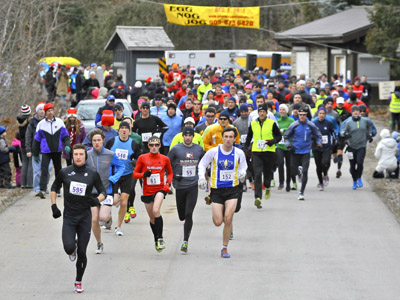 The 2014 version of the Egg Nog Jog was once again a success fir my Team Over The Top runners. As one of the toughest road races in North America (its 10.8 kilometre distance makes it unique), it attracts some of Canada’s top middle distance and cross country runners along with many age group elites. With the field restricted to 600 (and with only 521 finishing the 2014 race) and the course laid out in the Niagara Escarpment along the Terra Cotta Conservation Area, it has a special spot in Canadian running circles. It’s one of the many reasons I choose to organize a fall clinic around every year. Even though my team was the smallest ever (some had other commitments, some chose to train for the race but not do it, some were sick with the flu), those who did toe the line performed wonderfully. Results are as follows:
The 2014 version of the Egg Nog Jog was once again a success fir my Team Over The Top runners. As one of the toughest road races in North America (its 10.8 kilometre distance makes it unique), it attracts some of Canada’s top middle distance and cross country runners along with many age group elites. With the field restricted to 600 (and with only 521 finishing the 2014 race) and the course laid out in the Niagara Escarpment along the Terra Cotta Conservation Area, it has a special spot in Canadian running circles. It’s one of the many reasons I choose to organize a fall clinic around every year. Even though my team was the smallest ever (some had other commitments, some chose to train for the race but not do it, some were sick with the flu), those who did toe the line performed wonderfully. Results are as follows:
- Kerry Howes-Finch finished in 50:19 (a 4:40/km pace); 2nd out of 41 in her age group (to reach the podium yet again!) and 53rd overall out of 521. This after giving birth to her 2nd child in June, 2014 and, as she admitted, “not having my usual power endurance. All I can say is wait till she fully recovers from pregnancy #2 – her best results are yet to come…
- Sohail Nejat finished in 52:59 (a 4:55/km pace); 8th out of 16 and 82nd out of 521. He races in the Vibram FiveFingers usually and came in better prepared than other years. The focus to heavy training and perfect practice on the hills paid off in a fantastic race day result
- Michelle Bolhuis finished unofficially in 1:17:36 (a 7:11/km pace) and 28th out of 39 in her age group. I say “unofficially” as Michelle did not get registered in time but was allowed to race the course without a timing chip. Her result was 10 minutes faster than 2013 and she did the race in Sockwas. Normally a barefoot runner as per her coach (yours truly), Michelle decided to wear the Sockwas for fear of frostbite (that hit her last winter in Canada before she departed for her training base in Orlando, Florida). This represents a major improvement with even better results looming in 2015
- Patricia Lopes (not officially a Team Over The Topper but a pacing colleague of Michelle’s) finished with Michelle. Her support and encouragement were instrumental in keeping Michelle ‘in the zone’. At the same time, Patricia benefited from observing Michelle’s low, compact, mid foot style of safe running. It’s a style that Patricia has been trying to adopt this fall. Progress is being made…
The coach was justifiably proud of the team. This bodes well as they (and the rest of TOTT) head into the winter running clinic beginning January 4, 2015. For those on the team who did NOT race in the Egg Nog Jog, redemption at Around The Bay and Mississauga awaits!!
Coach Jeff



